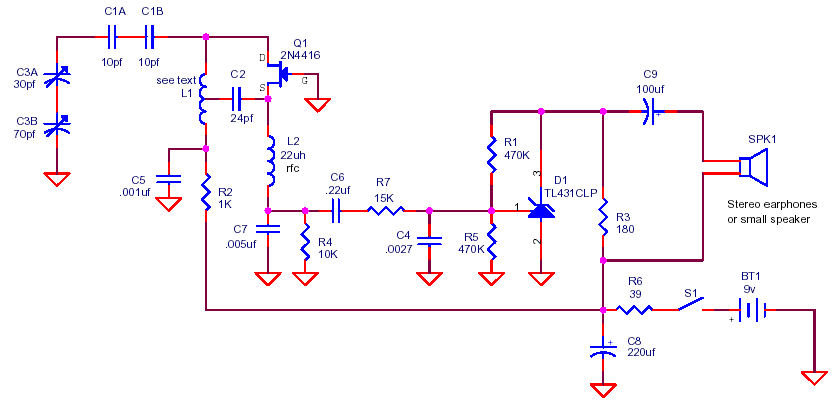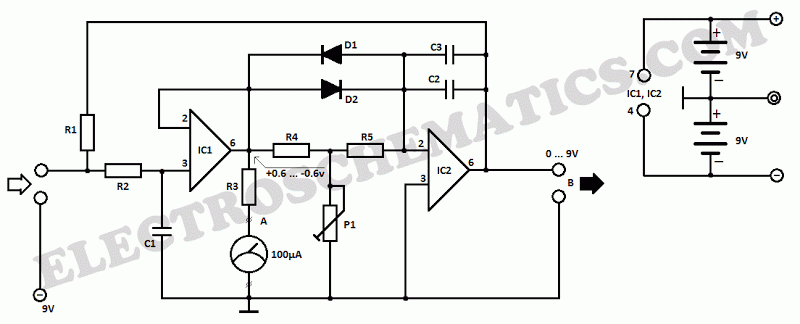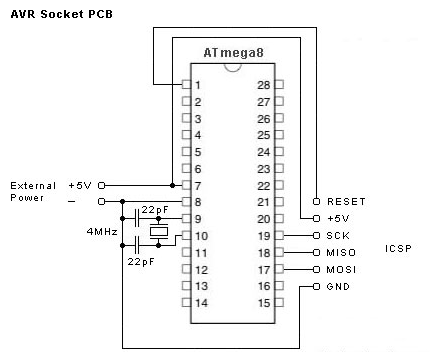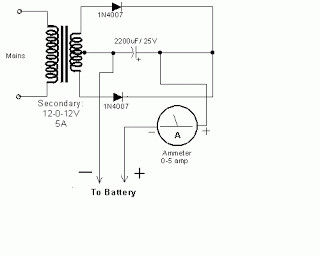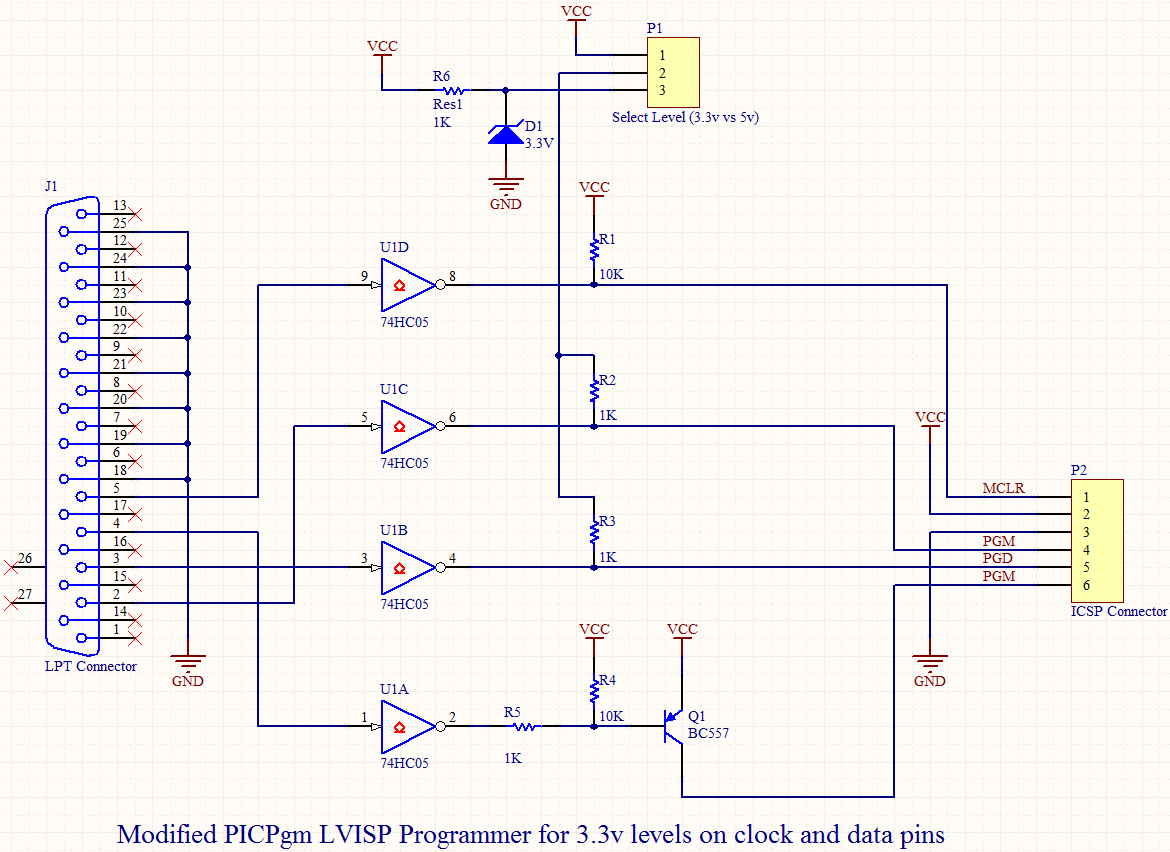
Simple Moisture Detector
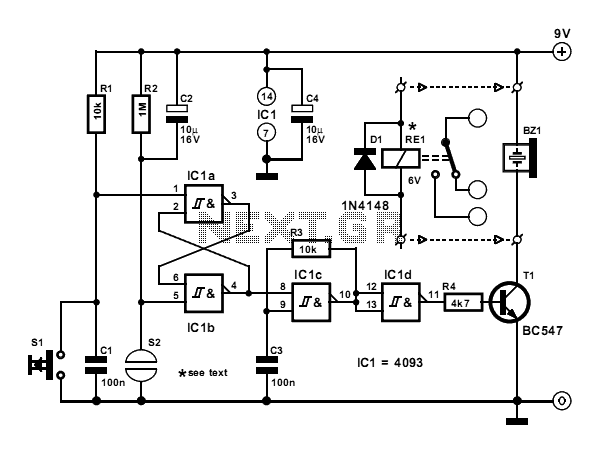
The function of this circuit is to sound a buzzer or, optionally, actuate a relay when a specific moisture level is detected between a pair of probes. The circuit incorporates a memory element in the form of a flip-flop (IC1a-IC1b), which enables or disables a tone oscillator (IC1c). The flip-flop can be reset either by capacitors C1 and C2 when the supply voltage is applied or by push-button switch S1. However, this reset may not deactivate the alarm, which will continue to sound until the probes are dry. The passive buzzer can be substituted with a relay that activates an externally connected sounder, lamp, or other high-power signaling devices. Due to the duty factor of the coil voltage being approximately 0.5, the relay should have a coil voltage lower than the supply voltage; a 6-volt relay is recommended for use with a 9-volt supply. The circuit consumes a modest standby current of 4 to 5 mA, which increases to about 40 mA when the relay is activated. The supply voltage is flexible and can range from 3 V to 15 V; however, a relay may not function properly if the supply voltage is below approximately 8 V. If the circuit is overly sensitive, the value of resistor R2 can be reduced.
This circuit serves as a moisture detection system, utilizing a pair of probes to monitor moisture levels in soil or other materials. When moisture is detected, the flip-flop configuration (IC1a and IC1b) plays a crucial role by storing the state of the moisture detection. The output from the flip-flop controls the tone oscillator (IC1c), which generates an audible tone through the buzzer. The inclusion of capacitors C1 and C2 ensures that the circuit initializes correctly upon power-up, providing a reset function that can also be manually triggered via switch S1.
The option to replace the passive buzzer with a relay expands the circuit's application to higher power devices, such as lamps or sounders, which require more current than a buzzer can provide. The relay's coil voltage rating must be carefully selected to ensure compatibility with the circuit's supply voltage, particularly noting that a 6-volt relay is suitable for a 9-volt supply. This design consideration is essential to prevent damage to the relay and ensure reliable operation.
In terms of power consumption, the circuit's standby current is efficient, allowing it to be powered for extended periods without significant battery drain. However, when the relay is activated, the current draw increases, highlighting the importance of selecting an appropriate power source that can handle the peak current requirements.
The flexibility of the supply voltage range allows for versatility in various applications, although caution is advised when operating below 8 V, as this may limit the functionality of the relay. Additionally, the sensitivity of the moisture detection can be adjusted by modifying the resistor R2, providing a means to fine-tune the circuit's response to varying moisture levels. This feature is particularly beneficial in environments with fluctuating moisture conditions, ensuring optimal performance of the detection system.The function of this circuit is to sound a buzzer, or, optionally, actuate a relay, when a certain moisture level is detected between a pair of probes. The circuit has a memory` in the form of a flip-flop, IC1a-IC1b, which enables or disables a tone oscillator, IC1c.
The flip-flop is reset either by C1 and C2 when the supply voltage appears, or by push-button S1. This may not reset the alarm, however, which will sound again until the probes are dry`. The (passive) buzzer may be replaced by a relay actuating an externally connected sounder, lamp or other high-power signalling device. Because the duty factor of the coil voltage is about 0. 5, the relay should be a type with a coil voltage which is lower than the supply voltage. A 6-volt type is suggested if the circuit is powered from a 9-volt supply. The circuit has a modest standby current consumption of between 4 and 5 mA. This rises to about 40 mA when the relay is actuated. The supply voltage is uncritical and may be anything between 3 V and 15 V. Note, however, that it may not be possible to use a relay if a supply voltage lower than about 8 V is employed.
If the circuit is found to be too sensitive, the value of resistor R2 may be decreased. 🔗 External reference
This circuit serves as a moisture detection system, utilizing a pair of probes to monitor moisture levels in soil or other materials. When moisture is detected, the flip-flop configuration (IC1a and IC1b) plays a crucial role by storing the state of the moisture detection. The output from the flip-flop controls the tone oscillator (IC1c), which generates an audible tone through the buzzer. The inclusion of capacitors C1 and C2 ensures that the circuit initializes correctly upon power-up, providing a reset function that can also be manually triggered via switch S1.
The option to replace the passive buzzer with a relay expands the circuit's application to higher power devices, such as lamps or sounders, which require more current than a buzzer can provide. The relay's coil voltage rating must be carefully selected to ensure compatibility with the circuit's supply voltage, particularly noting that a 6-volt relay is suitable for a 9-volt supply. This design consideration is essential to prevent damage to the relay and ensure reliable operation.
In terms of power consumption, the circuit's standby current is efficient, allowing it to be powered for extended periods without significant battery drain. However, when the relay is activated, the current draw increases, highlighting the importance of selecting an appropriate power source that can handle the peak current requirements.
The flexibility of the supply voltage range allows for versatility in various applications, although caution is advised when operating below 8 V, as this may limit the functionality of the relay. Additionally, the sensitivity of the moisture detection can be adjusted by modifying the resistor R2, providing a means to fine-tune the circuit's response to varying moisture levels. This feature is particularly beneficial in environments with fluctuating moisture conditions, ensuring optimal performance of the detection system.The function of this circuit is to sound a buzzer, or, optionally, actuate a relay, when a certain moisture level is detected between a pair of probes. The circuit has a memory` in the form of a flip-flop, IC1a-IC1b, which enables or disables a tone oscillator, IC1c.
The flip-flop is reset either by C1 and C2 when the supply voltage appears, or by push-button S1. This may not reset the alarm, however, which will sound again until the probes are dry`. The (passive) buzzer may be replaced by a relay actuating an externally connected sounder, lamp or other high-power signalling device. Because the duty factor of the coil voltage is about 0. 5, the relay should be a type with a coil voltage which is lower than the supply voltage. A 6-volt type is suggested if the circuit is powered from a 9-volt supply. The circuit has a modest standby current consumption of between 4 and 5 mA. This rises to about 40 mA when the relay is actuated. The supply voltage is uncritical and may be anything between 3 V and 15 V. Note, however, that it may not be possible to use a relay if a supply voltage lower than about 8 V is employed.
If the circuit is found to be too sensitive, the value of resistor R2 may be decreased. 🔗 External reference

